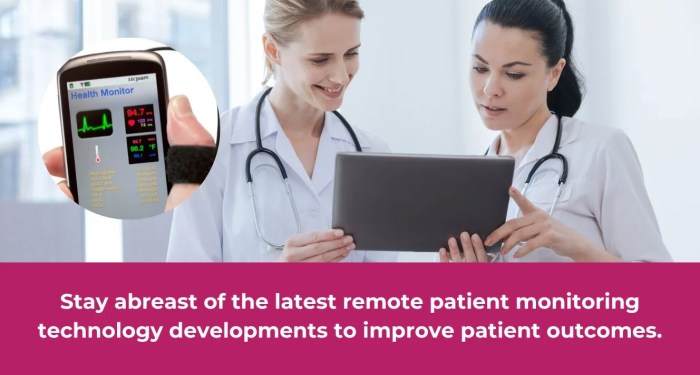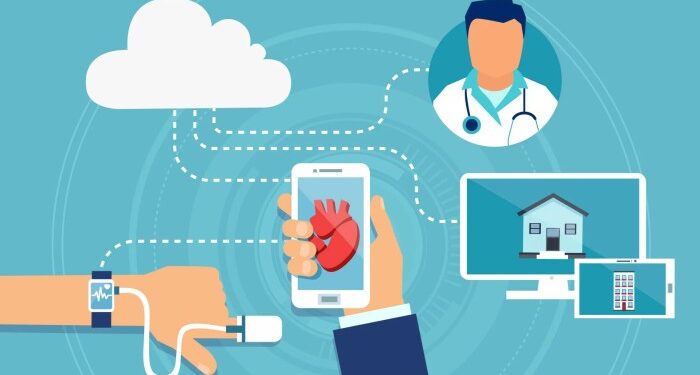Exploring the realm of Using Smart Technology to Improve Remote Patient Monitoring, this introduction sets the stage for a detailed discussion on how technology is revolutionizing healthcare practices. From wearable devices to data analytics, smart technology is reshaping the way patients are monitored remotely, offering convenience and efficiency.
In the following sections, we will delve into various aspects of remote patient monitoring using smart technology, highlighting its benefits, applications, data collection methods, communication enhancements, and security considerations. By the end, you will have a thorough understanding of how these technological advancements are transforming the healthcare landscape.
Introduction to Remote Patient Monitoring

Remote patient monitoring is a method of healthcare delivery that uses technology to monitor patients outside of traditional healthcare settings. This allows for the continuous monitoring of a patient's vital signs and other health indicators without the need for frequent in-person visits to a healthcare facility.
Importance of Using Smart Technology
Smart technology plays a crucial role in remote patient monitoring by providing real-time data transmission and analysis. This enables healthcare providers to track patients' health status more effectively and intervene promptly if any abnormalities are detected. The use of smart technology also enhances the efficiency of healthcare delivery and improves patient outcomes.
Benefits of Remote Patient Monitoring
- Improved Patient Engagement: Remote monitoring allows patients to actively participate in their own care by providing them with access to their health data and encouraging them to make healthier choices.
- Early Detection of Health Issues: Continuous monitoring enables healthcare providers to detect potential health problems at an early stage, leading to timely interventions and better outcomes for patients.
- Cost-Effective Care: By reducing the need for frequent hospital visits and preventing unnecessary hospitalizations, remote patient monitoring helps in lowering healthcare costs for both patients and providers.
- Enhanced Care Coordination: Smart technology facilitates seamless communication between different healthcare providers, ensuring that patients receive coordinated and comprehensive care.
Smart Technology Applications in Remote Patient Monitoring
Remote patient monitoring has been revolutionized by the advancements in smart technology. Various devices are now being used to monitor patients remotely, improving healthcare outcomes and patient experiences.
Types of Smart Technology Devices
- Wearable Devices: Smartwatches and fitness trackers are commonly used to monitor vital signs, activity levels, and even sleep patterns of patients.
- Medical Devices: Devices like blood pressure monitors, glucose meters, and pulse oximeters can be connected to smartphones for remote monitoring by healthcare providers.
- Sensor Technology: Sensors placed in the home environment can track movements, temperature, and even detect falls, providing valuable insights into a patient's well-being.
Utilization of Wearable Devices
Wearable devices play a crucial role in remote patient monitoring as they continuously collect data and transmit it to healthcare professionals in real-time. Smartwatches and fitness trackers can monitor heart rate, activity levels, and even detect irregularities that may indicate potential health issues.
Patients can also receive reminders for medication intake or exercise routines through these devices, promoting better adherence to treatment plans.
Role of Smartphone Applications
Smartphone applications have become essential tools in remote patient monitoring, allowing patients to input data, receive educational materials, and communicate with healthcare providers easily. These apps can collect data from wearable devices, track symptoms, and provide personalized feedback based on the information gathered.
Patients can also set medication reminders, schedule virtual appointments, and access their medical records through these applications, promoting proactive healthcare management.
Data Collection and Analysis
Smart technology plays a crucial role in enabling real-time data collection from patients undergoing remote monitoring. This data collection process involves various devices and sensors that continuously gather information about the patient's health status, symptoms, and vital signs.
Significance of Data Analytics
Data analytics is essential for interpreting the vast amount of information gathered from remote patient monitoring. By utilizing advanced algorithms and machine learning techniques, healthcare providers can analyze the data in real-time to identify trends, patterns, and anomalies that may require intervention.
This proactive approach allows for timely adjustments to the patient's treatment plan, ultimately improving outcomes and reducing the risk of complications.
- Monitoring vital signs such as heart rate, blood pressure, and oxygen saturation levels
- Tracking activity levels, sleep patterns, and medication adherence
- Assessing symptoms and pain levels reported by the patient
- Recording dietary habits and fluid intake
Remote Communication and Telemedicine
In remote patient monitoring, smart technology plays a crucial role in enhancing communication between patients and healthcare providers. This ensures timely interventions, improved care coordination, and better health outcomes.
Role of Telemedicine Platforms
Telemedicine platforms serve as a vital tool in remote patient monitoring by facilitating virtual consultations and enabling real-time communication between patients and healthcare professionals. These platforms allow for seamless interactions, remote diagnosis, and treatment planning.
Examples of Effective Teleconsultations
- Virtual Video Calls: Patients can connect with their healthcare providers through video calls to discuss symptoms, review treatment plans, and receive medical advice without the need for in-person visits.
- Secure Messaging: Smart technology enables secure messaging platforms that allow patients to communicate with their healthcare team, ask questions, and provide updates on their health status conveniently.
- Remote Monitoring Devices: Devices such as wearables and sensors can transmit real-time data to healthcare providers, enabling continuous monitoring of vital signs and health parameters, leading to proactive interventions and personalized care.
Security and Privacy Considerations

Ensuring data security and patient privacy are crucial aspects of remote patient monitoring with smart technology. Patient information is sensitive and must be protected from unauthorized access or breaches.
Data Encryption and Secure Platforms
- Utilizing end-to-end encryption to secure data transmission between devices and servers.
- Implementing secure platforms with multi-factor authentication to control access to patient information.
- Regularly updating security protocols and software to address emerging threats and vulnerabilities.
Compliance with Regulations
- Adhering to regulations such as HIPAA (Health Insurance Portability and Accountability Act) to protect patient data privacy.
- Ensuring compliance with GDPR (General Data Protection Regulation) for data protection of patients in the European Union.
- Following industry standards like ISO 27001 for information security management systems.
Wrap-Up
In conclusion, the integration of smart technology in remote patient monitoring presents a promising future for healthcare. With improved data collection, communication, and security measures, patients and healthcare providers alike stand to benefit from these innovations. As technology continues to advance, the possibilities for enhancing patient care through remote monitoring are endless.
FAQ Section
How does remote patient monitoring with smart technology improve patient outcomes?
Remote patient monitoring allows for continuous tracking of vital signs and health metrics, enabling early detection of issues and personalized interventions, ultimately leading to better health outcomes.
Are there any privacy concerns associated with using smart technology for remote patient monitoring?
Ensuring data security and patient privacy is crucial when implementing smart technology for remote patient monitoring. Encryption methods and compliance with regulations like HIPAA are essential to safeguard patient information.
What are some examples of wearable devices used in remote patient monitoring?
Wearable devices such as smartwatches, fitness trackers, and continuous glucose monitors are commonly used to monitor patients remotely, providing valuable health data in real-time.



